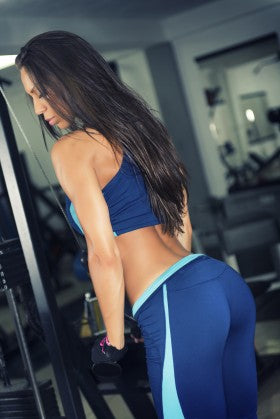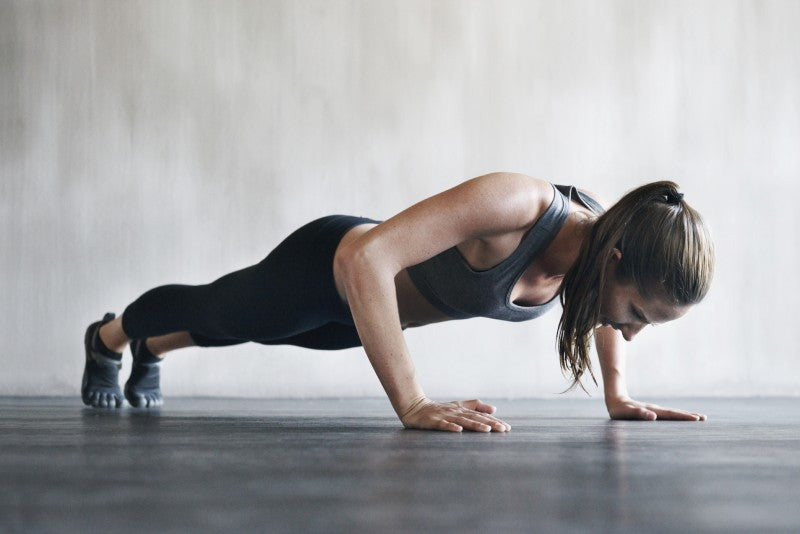Have your workouts and gym progress been subpar lately? If so, when?s the last time you added variation into your routine? If your gains have been lacking and you're wondering what small tweaks you can make to your routine without completely redesigning it, then this is the article for you.
The purpose of this article is to:
- Discuss the benefits of workout intensifiers.
- Explain the premise of each workout intensifier.
- Provide an implementation methodology so that you can use these intensifiers throughout your training career without burning out or getting injured.

To prevent burnout and overtraining, the number of intensifiers you perform per workout should be inversely related to the frequently with which you perform them.
The Benefits of Workout Intensifiers
When you think of the word intensity what comes to mind? If you?re like most, you think of max effort lifts using a high percentage (>85%) of your 1 repetition max (1RM). Lifting at such high intensities can be exceptionally draining on muscles, joints, and the central nervous system (CNS).
However, the beauty of the workout intensifiers in this article is that you can increase perceived exertion, or workout intensity, without necessarily having to use heavy loads week after week. Some of these intensifiers will increase your comfort with the current weight loads you're lifting and refine your lifting technique. This can also yield strength and size gains.
Workout intensifiers are also an excellent way to increase training density, which measures the amount of volume (weight x reps x sets) you perform over a given period of time. Assuming you are weight training for 60 minutes per session, workout intensifiers can increase volume via increased weight lifted, reps performed, sets completed, or a combination of all 3!
Not only are workout intensifiers a time-efficient way to increase volume without the need for marathon gym sessions and two-a-days, but they can also help you bust through muscle size and strength plateaus. Because you are increasing training density via increased volume, the exercises and muscle groups in which you choose to attack with workout intensifiers will undergo an intense and concentrated stimulus. And with the proper nutrition and routine, this additional stimulus will yield growth in both size and strength.
 Although we all have our favorite exercises (*cough* curls for the girls *cough*), workout intensifiers can also be employed on exercises you don't enjoy, or on lifts that make you feel weak whilst performing. By checking your ego at the door and using intensifiers on these not-so-fun exercises, you'll be able to bring up weak and lagging muscle groups quicker than if you stuck to performing traditional sets alone.
Although we all have our favorite exercises (*cough* curls for the girls *cough*), workout intensifiers can also be employed on exercises you don't enjoy, or on lifts that make you feel weak whilst performing. By checking your ego at the door and using intensifiers on these not-so-fun exercises, you'll be able to bring up weak and lagging muscle groups quicker than if you stuck to performing traditional sets alone.
Finally, workout intensifiers are an excellent psychological break from traditional straight sets (e.g. 3x8 or 1x8, 1x10, 1x12). I don't know about you, but after 12 weeks of the same set and rep scheme I admittedly lose the fire and passion I had when I first began the new routine. Workout intensifiers are an excellent way to vary your workout without having to significantly alter exercises and routine order; this variety could be just the mental kick in the pants you need to hit a new personal record!
Top 10 Workout Intensifiers
#1 - Extended Rest Drop Sets
Drop sets are one of, if not the most popular workout intensifier used by your average
Joe Gymbro.
To utilize drop sets, start with a weight and rep scheme that you would normally use during a traditional straight set (e.g. 1 set of 8 reps with 225lbs). After completing as many reps as you can using good form, decrease the weight by a set percentage of your 1RM, or by a set poundage (e.g. 25lbs). After decreasing the weight you should aim to perform as many, if not more repetitions than you performed using the heavier weight.
For example, if you hit 225x8 and then dropped the weight to 185lbs, you should aim to perform at least 8 reps. Make sure to terminate a set when you reach technical failure (re: you are unable to complete another rep with proper form). If your rest periods are short, then have a gym buddy or spotter expedite the weight removal process.
To track progression, record the total number of reps at each weight, the number of drops, and rest period between each drop.
Here's what a drop set would look like for bench press:
- 225x8 then rest 60 seconds
- 185x9 then rest 60 seconds
- 135x12 then rest 60 seconds
- 95x20

Negative reps are an excellent workout intensifier technique for priming the CNS and overloading the eccentric (re: lowering) portion of the lift.
#2 - Rest Pause Sets
Rest-pause sets are an excellent way to increase comfort with a given weight via increased volume.
To begin, select a weight and target rep range that you would use when performing a traditional straight set. After you've completed as many reps as you can using good form, you have two options:
- Rack/drop the weight.
- Hold on to the weight/allow the weight to remain on your back (a la squats).
Once you begin the rest portion of a set, rest for the allotted time (10-60 seconds). Use this time to mentally regroup and bring you breathing under control. After the rest period is up, perform as many reps as you can (with the same weight!) using proper technique.
Within one rest-pause set there can be a few as 2 mini-sets, or as many as 7 mini-sets. you'll quickly notice lactic acid build-up (aka the burn) using this method, but I?ve also gotten some of the best pumps from rest pause sets. it's important that you keep rest times strict using this method, so as to not skew results - use a workout buddy, clock or stopwatch to keep you honest.
To track progression, record the rep and weight used for each mini-set as well as the total number of reps. Aim to increase the total number of reps across the same number of mini-sets the next time you use this intensifier.

Rest pause sets work nicely with the
rep goal progression method, so when you hit X total reps over Y mini-sets, then you increase the weight the next workout.
Here's what a rest pause set would look like for back squats:
- 315x 6 then rest 30 seconds
- 315x3 then rest 30 seconds
- 315x3 then rest 30 seconds
- 315x2
During this example the lifter completed 14 reps across 4 mini-sets. If the rep goal had been 15, then I would continue to use 315 pounds the next time I squat. But if I had been using a rep goal of only 12 reps, then I would increase the weight used to 320 or 325.
#3 - Supersets/Trisets/Giant Sets
The term superset typically refers to performing two or more exercises in a circuit-like fashion. For this article I will refer to a superset as a grouping of 2 exercises, triset as a grouping of 3 exercises, and giant sets as a combination of 4+ exercises. There should little to no rest between exercises but you can rest 30-120 seconds between each superset, triset, or giant set.
As for exercise selection, the sky is the limit! I've found combining opposing muscle groups (chest & back), complementary muscle groups (back & biceps), or a random assortment of compound and isolation exercises to be effective. Regardless of the exercises you select, begin the set with the most technical and taxing exercise and perform less technical exercises as the exercise grouping progresses.
To track progression, record the weight and reps performed for each exercise as well as the rest period between each superset, triset, or giant set. You can progress by adding weight, adding reps, or by decreasing rest periods.
Here's what a superset would look like for a back and a chest exercise:
- Barbell Row 185x5, then immediately...
- Bench Press 185x10
- Rest 30 seconds
- Repeat superset 2-5 more times.
Here's what a triset would look like for triceps:
- Close Grip Bench Press 135x15, then immediately...
- Skullcrusher 75x8, then immediately...
- Tricep Kickback 30x10
- Rest 60 seconds
- Repeat triset 2-4 more times
Here's what a giant set would look like for legs:
- Back squat 225x10, then immediately...
- Good Mornings 135x10, then immediately...
- Leg Extensions 100x15, then immediately...
- Leg Curls 100x15
- Rest 120 seconds
- Repeat giant set 2 more times

If you're concerned about an intensifier ruining the rest of your workout due to over-fatigue, then employ it on an exercise towards the end of your workout
#4 - Forced Reps
Forced reps are an excellent workout intensifier for overloading the muscles by training past technical failure. it's crucial that you have a spotter for both safety and logistics reasons.
To begin, pick a weight and rep scheme that you would use for a traditional straight set. After performing as many reps as you can with good form, continue trying to complete reps with the understanding that your spotter will lightly touch the bar to assist you through a sticking point so that you complete these additional reps. The set terminates when you are unable to complete a rep without complete help by the spotter.
To track progression, record the weight used, total reps performed, reps performed without a spotter, as well as reps performed with a spotter. You can also note the common sticking points in which the spotter has to touch the bar to ensure you complete the rep.
Here?s what forced reps would look like for close grip bench press:
- 185 x 5 reps unassisted
- 3 reps assisted when bar was slightly off the chest
- 5 reps assisted when bar was slightly off the chest and at the midpoint of the lockout
#5 - Negative Reps
Negative reps are an excellent workout intensifier technique for priming the CNS and overloading the eccentric (re: lowering) portion of the lift. Depending on the exercise, you may need a spotter to assist you with the concentric (re: raising) portion of the lift.
I highly advise against performing negative reps with deadlifts and squats, as these exercises are not only generally taxing on your CNS, but your technique will start to break down rapidly. This could lead to serious injury if you're unable or unwilling to ditch the bar.
There are two approaches for negative reps - if you're looking to prime the CNS for a traditional straight set, then you can select a weight greater than your 1RM in which you cannot fully complete both the eccentric and concentric portion of the lift. Alternatively, you can select a weight that you can easily manage to complete multiple complete reps with (e.g. 5RM, 8RM, or 10RM) and utilize negative reps to perform more reps since you're only performing the eccentric portion (i.e. completing 8 eccentric reps using your 5RM).
Some excellent exercises for performing negative reps include bench press, curls, pull-ups, and dips. To track progress you should record the weight used, number of complete reps performed (if any) as well as the number of negative reps performed.
Here is what a negative rep set for pull-ups would look like:
- Bodyweight x 5 complete reps + 5 negative reps (lowering as slowly as possible), then rest 60 seconds
- Bodyweight x 8 negative reps (lowering as slowly as possible)

Beginners should employ one intensifier per workout. Intermediates can employ 1 or 2 intensifiers.
#6 - Run-the-Rack Set
The run-the-rack workout intensifier is ideal for dumbbell-based lifts. To begin, select the desired weight and target rep range that you'd normally use for a straight set. After performing the first set to technical failure (re: as many reps as you can perform with good form), place those dumbbells back on to the rack and grab the dumbbells that are one step lighter. Repeat this process for the desired number of drops; typically 1 set of 5-8 drops depending on the exercise and starting weight you select.
For example, if you start with 15lb dumbbells on lateral raises, then you'll quickly realize there are few very available drops compared starting with 80lb dumbbells on an exercise like shoulder press. Try to rest as little as possible during the set, resting only as long as it takes to switch dumbbells.
Here?s what a run-the-rack set looks like for dumbbell flies:
- 30x10
- 25x12
- 20x15
- 15x20
- 10x25
#7 - Range of Motion (ROM) Adjustment
Through the use of deficit reps and partials reps, ROM adjustment can be an effective workout intensifier for increasing both size and strength. Deficit reps put the body in a slightly less advantageous position without creating such a large change that the actual movement changes. Deficit reps increase the ROM of a lift, and if you keep the rep range the same, will likely require you to drop the weight compared to performing a traditional straight set.
Examples of deficit exercises include deficit deadlifts (standing on one or two 45lb plates), deficit lunges, and deficit push-ups (hands resting on blocks). Partial reps decrease the ROM of a lift, strengthen tendons and ligaments, as well as overload your CNS and muscular system which can increase your comfort with handling heavier weights.
Assuming you keep the rep range constant, partial reps allow you to use more weight than traditional straight sets. Examples of partial exercises include rack pulls, squat lockouts, and board presses. You can perform both deficit and partial reps using a traditional set and rep scheme but I have also found them to be effective in combination with rest pause sets.

To track progress, record the weight used, reps performed, as well as the ROM adjustment (e.g. one 45lb plate deficit or 12 inch partial bench ROM).
Here's what deadlifts would look like if you're employing a deficit:
- 405x5 reps with no deficit, then rest 90 seconds
- 365x8 reps with one 45lb plate deficit, then rest 120 seconds
- 365x3 reps with two 45lb plate deficit
Here?s what squats would look like if you're employing partial reps:
- 315x8 full reps, then rest 120 seconds
- 365x10 reps decreasing the ROM by 24 inches, then rest 120 seconds
- 405x8 reps, decreasing the ROM by another 12 inches
#8 - Paused Reps
Paused reps are an effective workout intensifier for reinforcing good form in weak or sticking points during a lift, increasing time under tension, and identifying when one muscle takes over when it shouldn't (re: overcompensating). If you're looking for form feedback while performing paused reps, then it's helpful to either video record your set or have a workout buddy analyze your form.
The pause is best utilized based where your form breaks down during a lift, and should typically lasts 3 to 5 seconds. For example, on bench press, if you're weak off the chest then pause at or slightly above the chest. Alternatively, if you're weak during lockout, then pause halfway through the pressing portion of the lift when the majority of the stress moves from your chest and shoulders to your triceps.
If you're really feeling masochistic you can pause at more than one location during the lift. If you decided to use the same weight as a traditional straight set then you should expect to perform fewer reps and if you decide to decrease the weight, expect a rep match or increase over a traditional straight set. To track progression, record the weight used, reps performed, length and location of the pause as well as the rest period between sets.
Here?s what a double paused rep set for deadlift would look like:
- 315 x 5 reps with a 3-second pause when the bar is slightly off the floor and a 5-second pause at knee level, then rest 120 seconds
- 315 x 3 reps with a 5-second pause when the bar is slightly off the floor and 3-second pause at knee level
#9 - Filler Exercises
Filler exercises are an excellent way to increase training density during rest and recovery periods. When performing traditional straight sets you typically perform a set and then rest for the prescribed amount of time before performing the next set.
The beauty of filler exercises is that you can perform them during this rest period without significantly affecting the performance of your next set. I'm a big fan of performing movements that prime the CNS like medicine ball through and box jumps, prehab exercises like rotator cuff external rotations, and bodyweight exercises like planks, hanging leg raises, push-ups, pull-ups, lunges, and calf raises.

If you do feel that these filler exercises are hindering your intra-workout recovery then try decreasing the number of reps.
The purpose of filler exercises is to provide additional training stimulus and reinforce good form so do not go anywhere close to failure on these exercises. If you do feel that these filler exercises are hindering your intra-workout recovery then try decreasing the number of reps per filler set or perform a filler exercise during every other or every third rest period.
To track progression you should record the exercise, reps performed, as well as during rest periods you performed these filler exercises.
Here?s what a push-up filler set would look like during deadlifts. Instead of 405x5 with a 90-second rest, try:
- 405x5
- 20 push-ups, then rest 60 seconds
- 405x5
#10 - Burnout Sets
Last but not least, let's discuss one of, if not the most brutal workout intensifier? burnout sets.
Burnout sets are extremely taxing on the CNS as they require you to perform an exercise to complete muscular failure (re: you couldn?t move the bar or dumbbell one more inch no matter how hard you try). I find that burnout sets are optimally performed using seated and lying barbell lifts, dumbbells, machines, and cable implements.
I highly advise again performing burnout sets with deadlifts and squats. These exercises are not only generally taxing on your CNS, but technique over the duration of a set has a tendency to break down rapidly. This could lead to serious injury if you're unable or unwilling to ditch the bar.
I've also found that burnout sets combine nicely with drop sets, rest pause sets, and negative reps. For burnout sets you NEED to ensure you have a spotter or an implement (e.g. squat cage, safety pins) set up so that if you have to ditch the bar, then you won't get injured. If the spotter is a stranger explain beforehand the concept of a burnout set and ask him or her only to intervene if you are physically unable to complete the rep or if the bar unexpectedly reverses momentum (e.g. you?re performing the pressing portion of the bench press and it suddenly begins falling back down towards your chest).
To track progression you should record the weight used and reps performed for each burnout set and aim to beat individual reps performed at each weight as well as the total number of reps you performed across all burnout sets.
Here?s what a burnout set + rest pause would look like for seated incline dumbbell press:
- 80x10, then rest 45 seconds
- 80x5, then rest 45 seconds
- 80x3, then rest 30 seconds
- 80x0 (complete muscular failure was reached so the set was terminated)
How to Implement Workout Intensifiers Effectively

Now that you understand the value of, and have a solid list of workout intensifiers, let's discuss how to implement them into your training program without overtraining, burning out, or becoming injured.
Firstly, be wise if you're looking to combine multiple intensifiers for one exercise. For example, combining rest pause and partial reps can be effective but combining rest pause, burnout sets, and negative reps is a recipe for disaster.
I recommend adjusting the number of intensifiers you complete per workout based on your training experience level.
- Beginners should employ one intensifier per workout.
- Intermediates can employ 1 or 2 intensifiers.
- Advanced trainees can utilize up to 3 intensifiers per workout effectively.
To prevent burnout and overtraining, the number of intensifiers you perform per workout should be inversely related to the frequently with which you perform intensifiers. The more intensifiers you use per workout, the less frequently you should perform workouts involving numerous intensifiers. Additionally, taper your use of intensifiers leading up to a lifting competition involving max effort lifts to ensure you CNS stays fresh.
If you're concerned about an intensifier ruining the rest of your workout due to over-fatigue, then employ it on an exercise towards the end of your workout. Otherwise, accept that if you perform an intensifier on the first exercise of your workout that subsequent exercises may suffer; these are the trade-offs we must make!
Lastly, listen to your body. If you feel like to adding another intensifier to your workout above the guidelines I mentioned that's okay, but also be willing to accept that there may be days when you don't feel like or physically are unable to incorporate workout intensifiers without workout performance significantly decreasing. Workout intensifiers are meant to enhance your workouts, not detract from them.
Now that you're been armed with the knowledge of workout intensifiers, try them during your next gym workout and comment with your experiences. Now get in the gym, crush those weights, and obtain those gains!


 Although we all have our favorite exercises (*cough* curls for the girls *cough*), workout intensifiers can also be employed on exercises you don't enjoy, or on lifts that make you feel weak whilst performing. By checking your ego at the door and using intensifiers on these not-so-fun exercises, you'll be able to bring up weak and lagging muscle groups quicker than if you stuck to performing traditional sets alone.
Although we all have our favorite exercises (*cough* curls for the girls *cough*), workout intensifiers can also be employed on exercises you don't enjoy, or on lifts that make you feel weak whilst performing. By checking your ego at the door and using intensifiers on these not-so-fun exercises, you'll be able to bring up weak and lagging muscle groups quicker than if you stuck to performing traditional sets alone.
 Rest pause sets work nicely with the rep goal progression method, so when you hit X total reps over Y mini-sets, then you increase the weight the next workout.
Rest pause sets work nicely with the rep goal progression method, so when you hit X total reps over Y mini-sets, then you increase the weight the next workout.

 To track progress, record the weight used, reps performed, as well as the ROM adjustment (e.g. one 45lb plate deficit or 12 inch partial bench ROM).
To track progress, record the weight used, reps performed, as well as the ROM adjustment (e.g. one 45lb plate deficit or 12 inch partial bench ROM).
 Now that you understand the value of, and have a solid list of workout intensifiers, let's discuss how to implement them into your training program without overtraining, burning out, or becoming injured.
Now that you understand the value of, and have a solid list of workout intensifiers, let's discuss how to implement them into your training program without overtraining, burning out, or becoming injured.